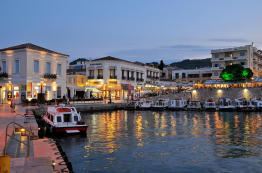Geography
Our Pretty Green Isle
At 51 nautical miles from Piraeus, Spetses is the southern-most of the Saronic Islands. It has an area of 25.5km2, with its sole road, tracing the perimeter of the island, measuring 24km in length. The population of the island numbers around 4,000, the most of whom are to be found in the main settlement on the island, Spetses Town which spreads out over an area of around 4km along the coast. There are also a small number of summer houses and one or two hotels around the area of Ayios Anargyrios, on the opposite side of the island.
The first thing we see as the boat approaches Spetses is the white town with its red-tiled roofs, set against a back-drop of pine trees. Starting in the western corner, we can make out the 'Engineers' Settlement', elevated above the College, the Spetses Hotel, and the bay of Kounoupitsa, which is filled with boats and caiques. Coming in towards the town, there is the old Daskalaki Factory, now the Nisia Hotel, the imposing grandeur of the Possidonion Hotel (built in 1914, it's the oldest hotel on the Greek Islands), and the main harbour of the island, the Dapia, which literally translated means, the Fortress.
Spetses' architecture owes much to its sometime Venetian overlords, who brought with them Italian finesse, attention to detail and many Arab craftsmen who, in their turn, left their mark on the
buildings of the island. Thanks to some (for once) sensible legal restraints, it is strictly forbidden to build modern and high-rise buildings. The beauty of the island today is also greatly indebted
to the clause which the great benefactor, Sotirios Anargyros, added to his bequests to the islanders. Between 1913 and 1923, he had methodically bought up over 45% of the total island area, and this
he left to the island of Spetses, with the prerequisite that the pine forest area ( he had re-planted around 100,000 trees during his lifetime), would never be built upon.
The fine old houses making up the town's interior can just about be seen from the sea. Above the Dapia and Possidonion rises the area of Kastelli, home to the first major settlement of the island. To
the east, the tall bell-tower of St. Nicholas prevails amongst the old captains' houses, erasing, if it were really necessary, any doubt that you are anywhere other than Spetses.
The Old Harbour, or Palio Limani, is hidden behind the headland of the Faros (lighthouse) and glides into view shortly before the boat docks. Here the sun-seekers of the day who have metamorphosed
into the fun-seekers of the night, will find most of the bars and clubs they have heard so much about. It is also the area that holds the most magnificent of the traditional-styled villas, many
belonging to members of the European jet set.
Once disembarked, we are greeted by the freshly restored building which once housed the town hall of Spetses. The narrow inner streets, filled with shops as different and enticing as the wonderful
mezes served with your lunchtime ouzo, provide a perfect place to stroll and while away the hours. The various roads out of town will take the unsuspecting traveller in different directions, which in
their turn will reveal all the secrets that Spetses has hidden.
The highest point on the island is Profitis Ilias, at 285m. It lies roughly central to the breadth of the island and affords two spectacular views, to the north, of Kosta, Porto Heli and the Dydima
mountains, and on the opposite side of the Argolicos Gulf, Leonidio, to the south. There are paths at various points on the island that will take you there, as well as to the many other Spetses
beauty spots. These paths make for a number of lovely mini-hikes, all over the central part of the island.
Spetses has very little in the way of natural water supply, so the island's needs are met by the water-carrier boat which makes its daily trip from the mainland, and unloads at the Dapia.
The island was known, before the 18th century, as Pityousa, meaning "pine-clad". Then Albanian settlers corrupted the name to 'Petsa', which is what the island was called until the last century. The
name Spetses, an Arvanite corruption of the Venetian 'Isola di Spezie' (Spezie: Italian word for spices), or 'Isle of Spices', more befits the island that we know today. The Venetians may have also
called it 'Spezie' as it reminded them of the port on the west coast of Italy called 'La Spezia'. Due to two terrible fires in 1990, and 2000, the once dense pine forest is reduced to some, if still
beautiful, much diminished untouched areas. Despite this, the island retains its natural beauty, not only in the remaining pines and the wide variety of wild flowers, but also in the vast array of
aromatic herbaceous plants which grow beneath low-shrub thickets, pine and gorse. The most infamous of the herbs growing wild on Spetses is 'throubi', which is a kind of thyme with a particularly
pungent smell. Local folklore has it that the smell of the throubi is responsible for the islanders being slightly crazy!
This category was compiled with much help from:
"The Islands of the Argosaronic Gulf" by Betty Kagia, published by Grecocard Publications 1995.
and
"Undiscovered Spetses" published by 'Road Publications' June 2004
ISBN 960-8189-45-4 "Ανεξερεύνητες Σπέτσες" by Petros Haritatos



